Collaborative Unit - MA Design for Social Innovation and Sustainable Futures
University of the Arts London
Project Partner and Client - Newham Council
Research | Collaboration | Social Impact | Community
NEWHAM COUNCIL- 15 MINUTE NEIGHBORHOOD
Brief
Imagine what a future, eco-friendly just and sustainable ‘15 minute neighborhood’ might look for a demographic represented by your group’s persona. Your speculative design work will be a complement to the more pragmatic outcomes of the citizen assembly. Newham council actively encourages radical proposals to help citizens think beyond what they may perceive to be possible in the here and now.
Guiding Question
How can we make sure to build towards futures where our local neighborhoods are vibrant communities where people can work, meer, shop, and access the everyday services they need within a 15 minute walk or cycle from home?
Team
Marte Ellefsen | Valentine Emens | UJ Chiang
Tanvi Khandelwal | Yifan Niu | Chenyu He


Team Response to the Brief
We did the table of response activity as a group to understand key points from the brief and steer the project forward. This particularly helped us all to get on the same page and take the immediate next steps. As for persona interpretation, we found a ‘Demographic segmentation’, on which we generated our initial assumptions for Maxwells' family.
![]()
We did the table of response activity as a group to understand key points from the brief and steer the project forward. This particularly helped us all to get on the same page and take the immediate next steps. As for persona interpretation, we found a ‘Demographic segmentation’, on which we generated our initial assumptions for Maxwells' family.
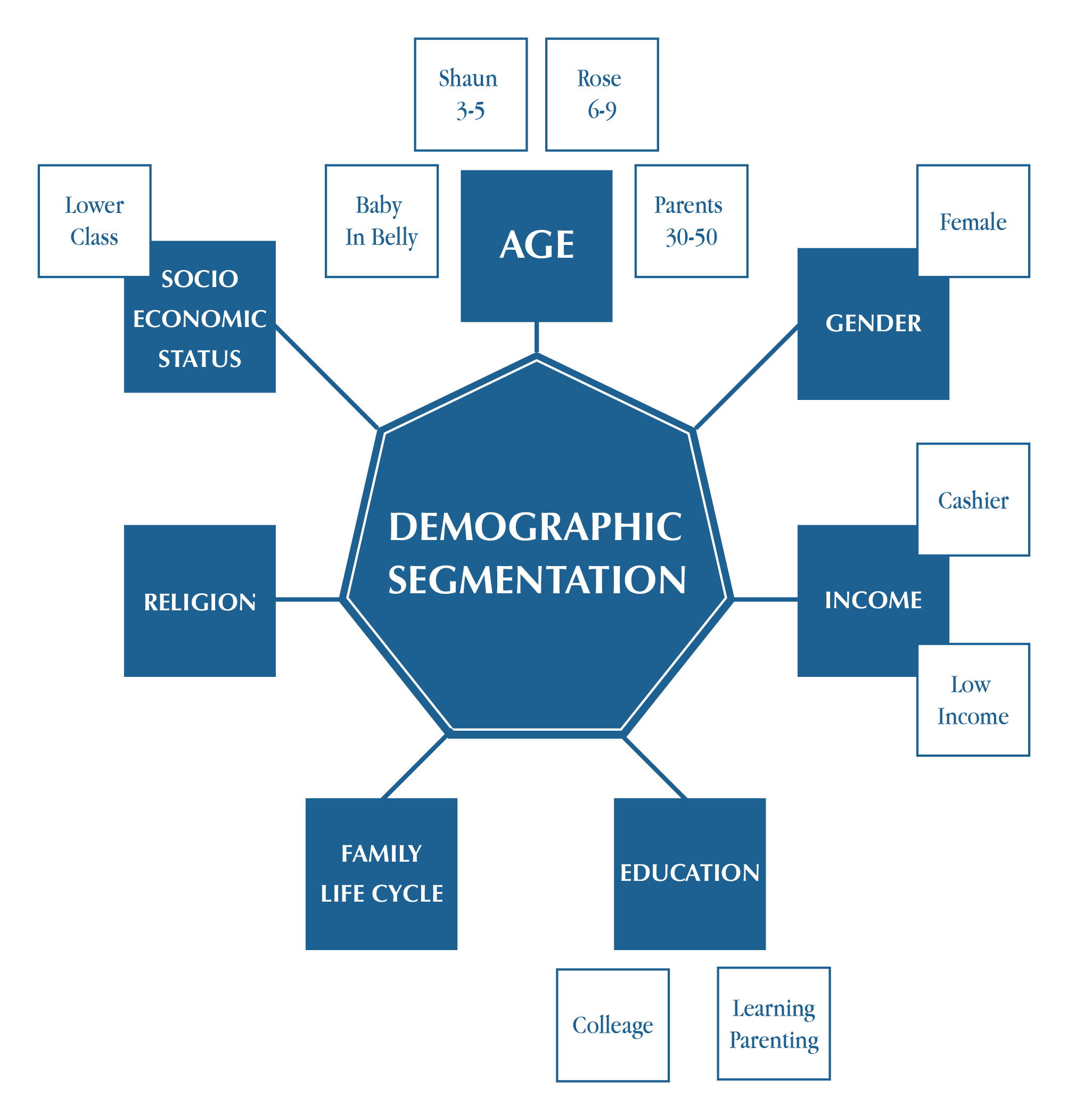
Persona Identification and Building
The Maxwells (a family of 4 and a baby on the way) are essentially the persona our group had to work with but through all the initial research, feedbacks from tutors, the exercise of tracing signals and visit to Newham made us want to condense our research relating to one of the family members i.e.
Leila- the mother.
Few aspects that made her the center of focus for this project were
- Struggling with bouts of depression
- Working mother of 2 and pregnant with a third
- Woman of color with an immigrant status
As we went through all the threads, we kept coming back to Leila and making her the focus for this project. This gave us the opportunity to focus on the most pressing issues that affect her and possibly this demographic in Newham.

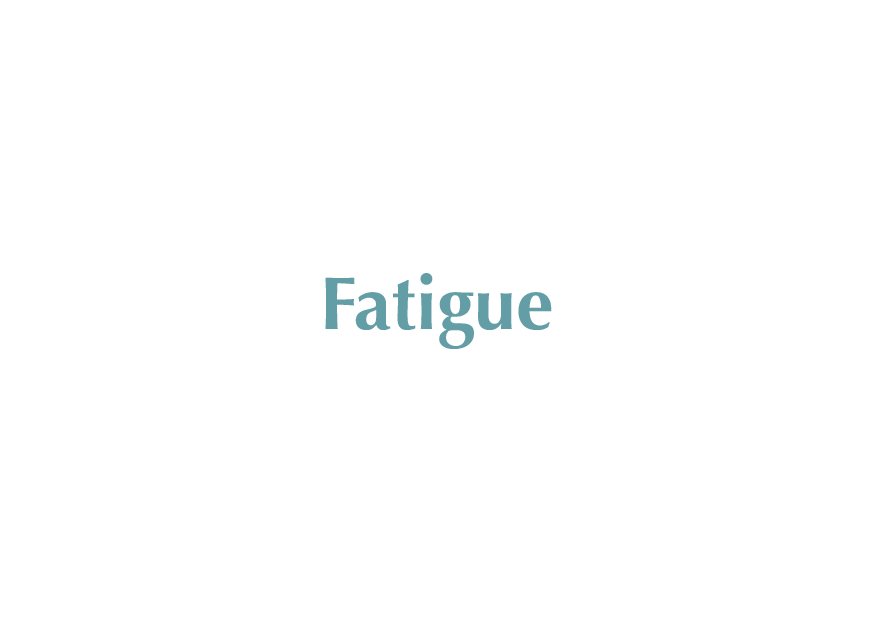

Scope of Research
Secondary Research
Our research was driven by the topics that we thought were essential for our progress at this point. We asked ourselves questions like ‘How do issues or topics interrelate or impact each other?’ or ‘What insights are we looking for? Why are we doing this? What does it contribute to?’
These topics were directly related to Leila while a few others were part of the brief that we thought were worth exploring.
- Depression and how it relates to culture, pregnancy, and parenthood
- Mental health services and strategies
- 15-min city definition and applications
- Newham history and resources
- Speculative design approach
We reconvened after individually conducting our secondary research and talked each other through our research topics, offering our thoughts, and writing comments on Miro. From here, we observed how many of our topics were linked and mapped out a systems map. This exercise also contributed to our interest in the identification of the senses and their link to urban design.
(link to the deatiled process document at the end of the page)
Primary Research
We contacted the representative of the council who was involved in this unit with us along with some other mental health practitioners who work for the mental health services in Newham. None of the responses indicated that there is any work being done to improve the surroundings in order to improve mental health of people in Newham. This gave us even more motivation to pursue this concept further.
Secondary Research
Our research was driven by the topics that we thought were essential for our progress at this point. We asked ourselves questions like ‘How do issues or topics interrelate or impact each other?’ or ‘What insights are we looking for? Why are we doing this? What does it contribute to?’
These topics were directly related to Leila while a few others were part of the brief that we thought were worth exploring.
- Depression and how it relates to culture, pregnancy, and parenthood
- Mental health services and strategies
- 15-min city definition and applications
- Newham history and resources
- Speculative design approach
We reconvened after individually conducting our secondary research and talked each other through our research topics, offering our thoughts, and writing comments on Miro. From here, we observed how many of our topics were linked and mapped out a systems map. This exercise also contributed to our interest in the identification of the senses and their link to urban design.
(link to the deatiled process document at the end of the page)
Primary Research
We contacted the representative of the council who was involved in this unit with us along with some other mental health practitioners who work for the mental health services in Newham. None of the responses indicated that there is any work being done to improve the surroundings in order to improve mental health of people in Newham. This gave us even more motivation to pursue this concept further.

Shaping our Story
After we shared our individual research and analysis, and multiple meetings later, we found the direction to go forward— using different senses as experiences to help Leila elevate her mental well-being in her day-to-day life. As a result, we initiated further secondary research related to how sensory design co-relates to depression, in an attempt to establish non-medical interventions as an option.
Approach - Sensory Design
Sensory design is a design method where you create experiences and products that engage the spectrum of the human senses. When thinking of this in a broader context, space is so much more than just its appearance. The user's experience can strongly be affected by smells, sounds, and textures. This way sensory design can transform interactions between people and build an environment that impacts the deeper sense of belonging. When we were researching this topic, we were increasingly drawn towards the road of mapping and how we could use mapping as a way of creating a connection between our secondary research and potential proposals for Newham.
We determined that depression often causes depletion of all senses, leading to emotional numbness. This can result in feeling numb to surroundings, as well as feelings, leaving the individual feeling disconnected from the world. Something we assumed Leila could be feeling. A way to combat this is to engage the senses in a variety of ways. We took this insight and went on the understand how Leila’s senses might be affected by her surroundings.


Sensory Data Mapping in Newham
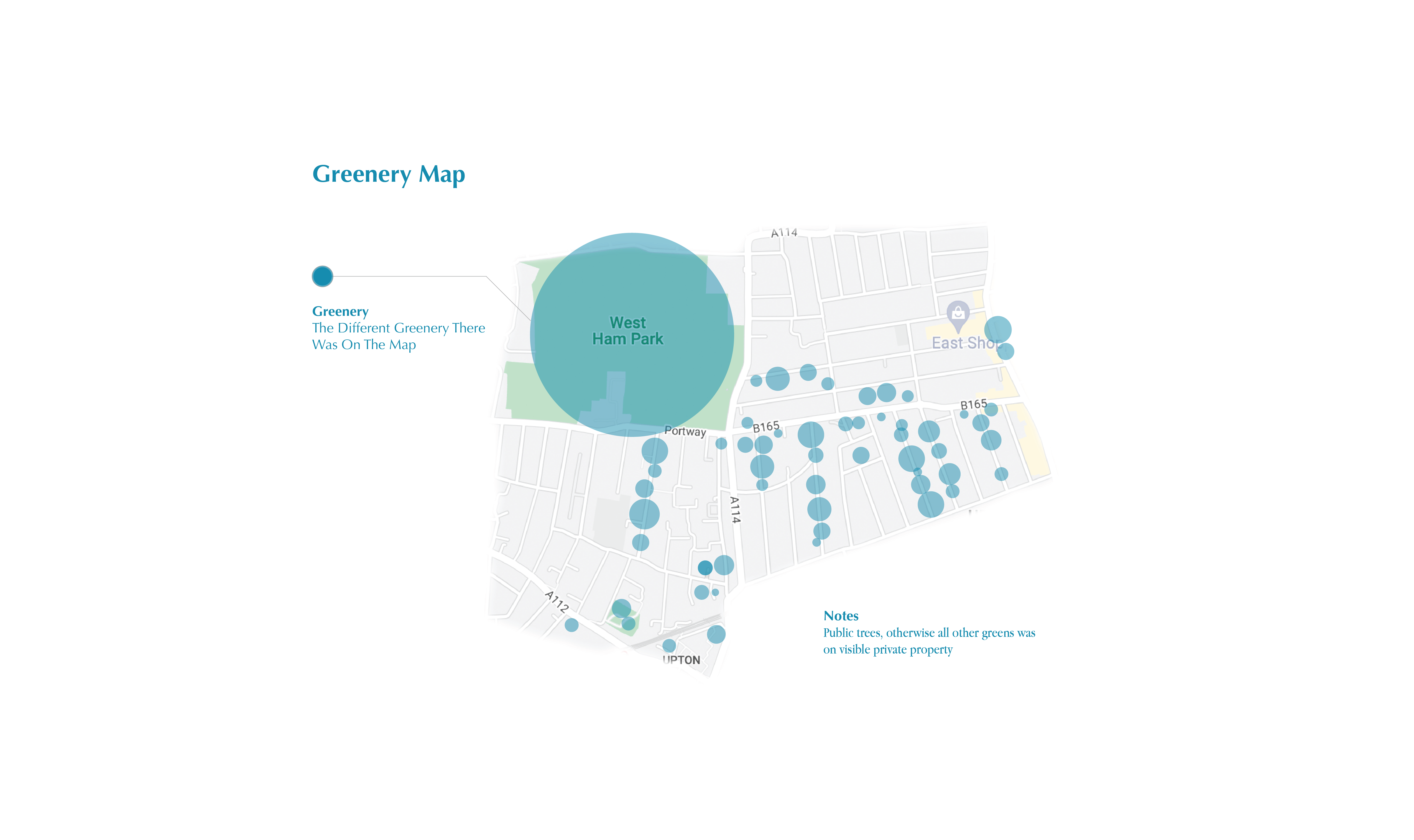

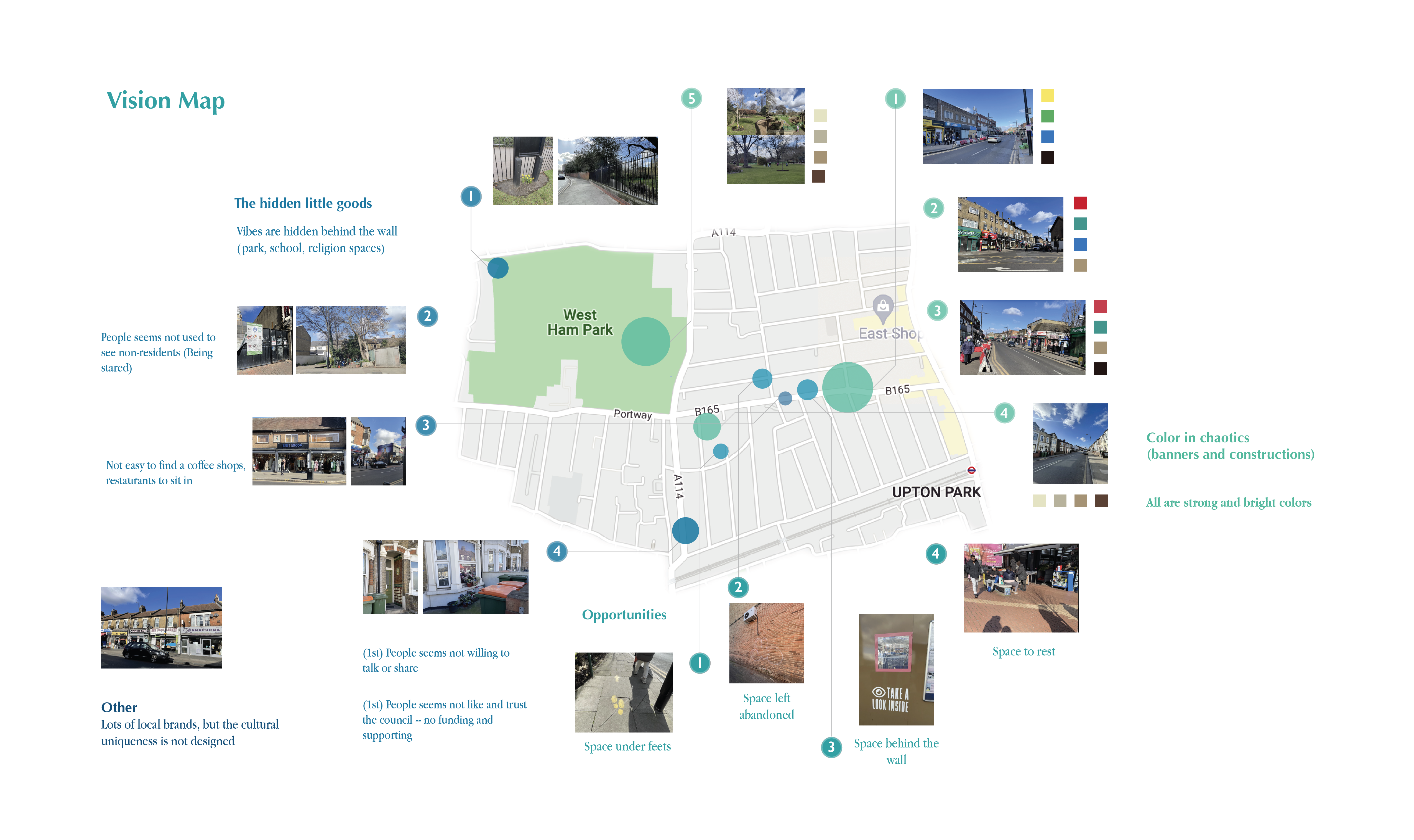
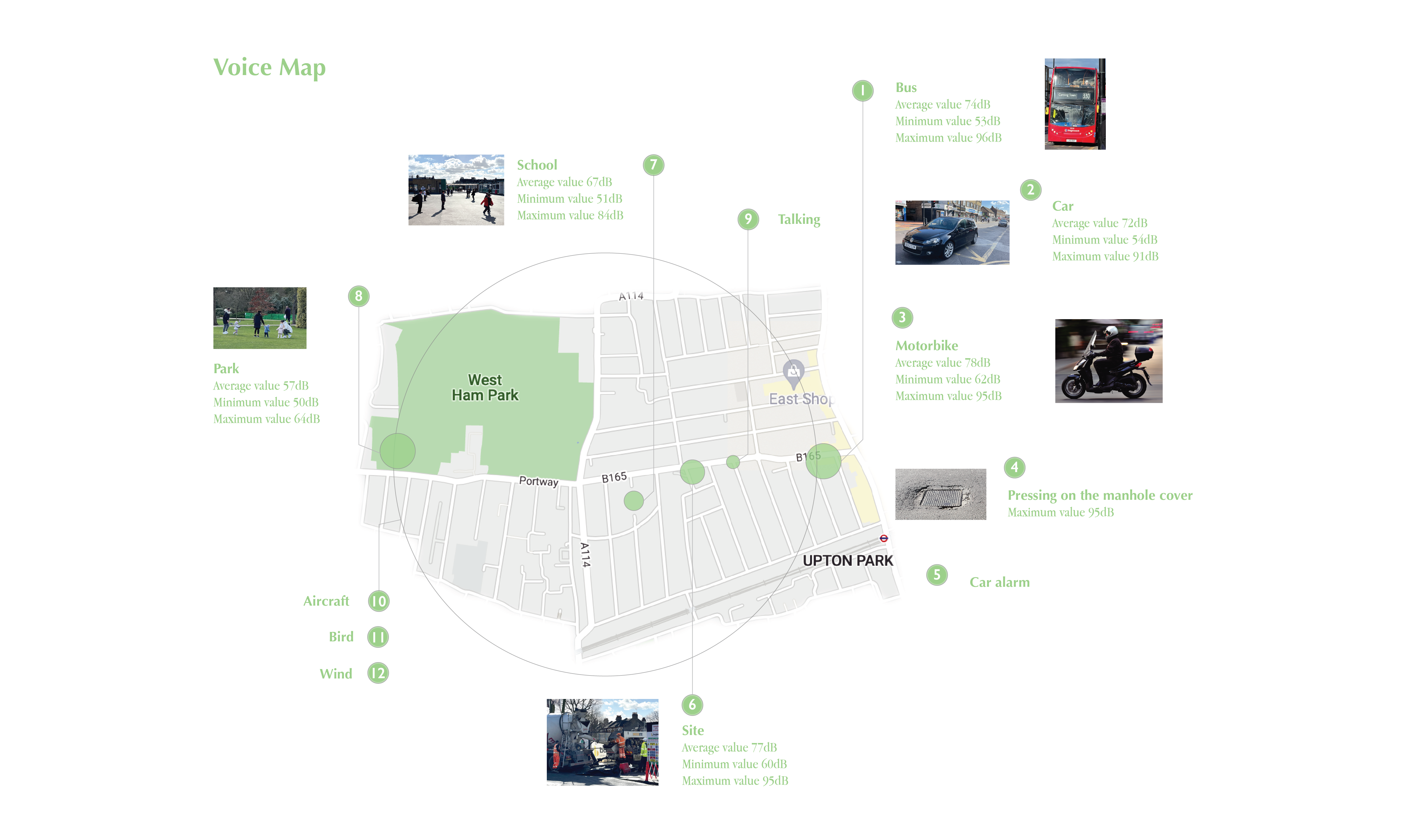





Ideation Workshop
Sensory trip to Newham gave us lots of inspiration and reflections. To turn what we learned from the field trip into ideas, we had a small workshop in which we asked ourselves: “What is the outcome we would like to see?” “What could be the change/ non-change or intervention, and why?”
Our map of Leila’s interrelated problems revealed that due to her various cultural barriers combined with her busy schedule as a parent working a part-time job: it would be especially challenging for her to take that step towards receiving treatment for her depression. Therefore, before brainstorming, we agreed there were two keywords that our ideas should fulfil: seamless and inviting interactions (for kids or parents).


“NOT CHANGE NEWHAM BUT BRING OUT WHATS ALREADY THERE”
One of our key takeaways at this point was the stark contrast between the high streets and the park in terms of sensory experience: from loud city sounds and surroundings to sounds of nature. So we thought about, how could we bring that feeling of serenity that we all felt at the park into the hustle and bustle of the city.
We also considered how we could implement sensory experiences relating to nature in daily walks. These points will engage the senses through color, sound, art, quotes, and joyful things to look out for and experience.
We wanted to be part of facilitating bringing out of existing marvels in Upton, during A to B journey, helping people to discover “hidden gems” they never noticed such as clips of murals, windowsills, etc
One of our key takeaways at this point was the stark contrast between the high streets and the park in terms of sensory experience: from loud city sounds and surroundings to sounds of nature. So we thought about, how could we bring that feeling of serenity that we all felt at the park into the hustle and bustle of the city.
We also considered how we could implement sensory experiences relating to nature in daily walks. These points will engage the senses through color, sound, art, quotes, and joyful things to look out for and experience.
We wanted to be part of facilitating bringing out of existing marvels in Upton, during A to B journey, helping people to discover “hidden gems” they never noticed such as clips of murals, windowsills, etc
Inspiration and Testing
From further conversations and lectures on various ways of approaching sensory design in an urban setting, we came accross biophilic city scapes and how they contribute in improving mental wellbeing holistically. Sticking on to the idea, we went on the field again to get an understanding from recent mothers or to-be mothers as to what would be their reaction if something like this was introduced in Newham. We spoke to women from different cultures and backgrounds who unanimously agreed that Newham lacks character and introducing ideas such as these would instantly make their day-to-day life mentally less exhausting.
We used the theory of change framework to clarify our project priorities by defining our long term and short term goals and the steps we would need to take to reach them.




Proposal
Utilizing outdoor areas for interactions, such as pavements, empty walls, abandoned signs & benches, we wanted to integrate nature-related sensory experiences into the urban landscape. The location of these sensory spots would take into account a 15-minute walk, all being within a 15-minute radius of Upton Park Station - our selected focus area. The sensory spots would change and refresh seasonally and randomly every few months, creating a sense of excitement, as citizens keep an eye out for new sensory appearances.
This would also hopefully avoid citizens becoming used to / numb to these devices over time. These interactions would not be limited to Leila or individuals suffering from mental illness and would welcome participation from everyone of all ages and backgrounds by being eye-catching and inviting.
The information about these sensory devices would be available at ‘Hot Spots’ in Newham’s parks, for people to optionally access. These spots will contain a map with additional information about the sensory spots and their intent as “mood boosters”. A QR code linking to a website or social media platform will be available, where citizens can share their experiences interacting with these devices. They could also optionally share their experiences with mental health and/or illness, useful coping strategies, as well as how these sensory devices might have helped them.
Below are some Before-After of images taken in Newham and manipulated to add a sensory experience to it for this project.



Watch your step! (Art)
A staircase, with a nature-themed mural. This particular staircase is in the middle of Queen’s Market leading to the car-park
A staircase, with a nature-themed mural. This particular staircase is in the middle of Queen’s Market leading to the car-park


Walls can speak (Art, message)
An eye-catching uplifting or inspirational quote
An eye-catching uplifting or inspirational quote
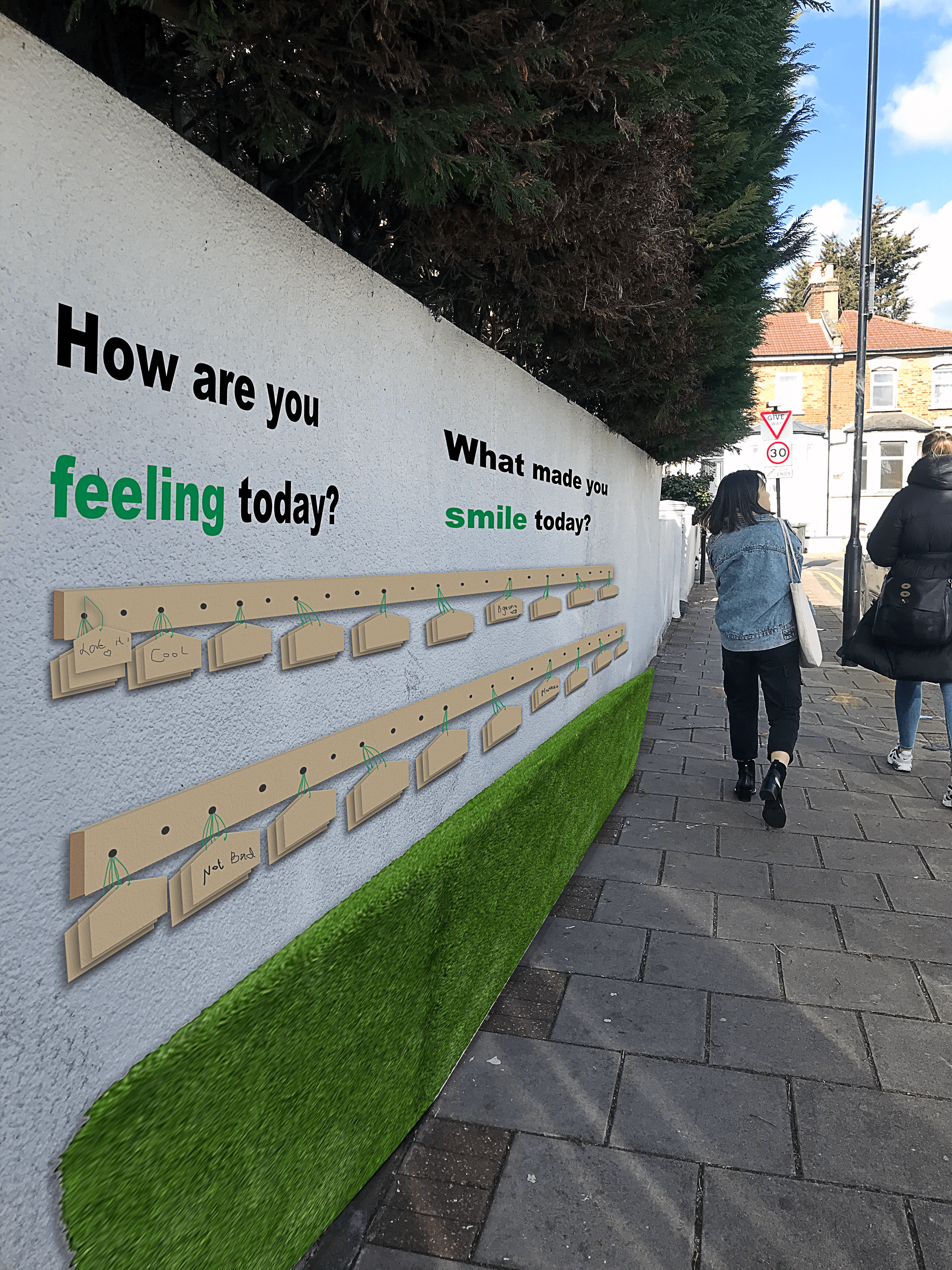


Let’s Chat (Community Messages)
A textile wall, with prompt questions like : “How are you feeling today & what made you smile today”
A textile wall, with prompt questions like : “How are you feeling today & what made you smile today”


Let’s Play! (Colour, Sound)
A sound system activated by footsteps. The sounds would include natural sounds of birds, water trickling, wind, leaves rustling etc
A sound system activated by footsteps. The sounds would include natural sounds of birds, water trickling, wind, leaves rustling etc


Please Sit Down (Light, colour and touch)
A plant themed bus stop, with grass like texture coving the bench, encouraging touch, and glass, reflecting light, creating shades of green and blue.
A plant themed bus stop, with grass like texture coving the bench, encouraging touch, and glass, reflecting light, creating shades of green and blue.


Fly away shadows! (light, sun)
Shadows art of birds on the streets.
Shadows art of birds on the streets.
Future
The next step would be to adopt collective design, by involving the people of Newham in the design process and creation, to incorporate their own personal & cultural touch. This could be done through community events led by local arts & culture centres such as the Trinity Centre or Applecart Arts.
Due to time constraints, we were unable to create physical prototypes of our sensory experiences to test on key stakeholders. However, we did get a chance to share some pictures of our rough sensory ideas to locals in Newham during our visit, receiving consistent positive feedback and excitement.
The team worked collaboratively with each one giving 100% of their skills and strengths. The project concluded on a positive note and in hope for Newham council to actually consider these proposals one day. AAs designers and researchers, this one of our biggest and most challenging real world project that we were given an opportunity to work on.
The next step would be to adopt collective design, by involving the people of Newham in the design process and creation, to incorporate their own personal & cultural touch. This could be done through community events led by local arts & culture centres such as the Trinity Centre or Applecart Arts.
Due to time constraints, we were unable to create physical prototypes of our sensory experiences to test on key stakeholders. However, we did get a chance to share some pictures of our rough sensory ideas to locals in Newham during our visit, receiving consistent positive feedback and excitement.
The team worked collaboratively with each one giving 100% of their skills and strengths. The project concluded on a positive note and in hope for Newham council to actually consider these proposals one day. AAs designers and researchers, this one of our biggest and most challenging real world project that we were given an opportunity to work on.
Links
Complete Process Document
https://drive.google.com/drive/folders/1BRr1HofZi0eaaFTz310ycSrcyqJtkt8e?usp=sharing
Youtube Video of the Final Presentation https://www.youtube.com/watch?v=Cs7Js6jaZtM&list=PPSV
THANK YOU!
Complete Process Document
https://drive.google.com/drive/folders/1BRr1HofZi0eaaFTz310ycSrcyqJtkt8e?usp=sharing
Youtube Video of the Final Presentation https://www.youtube.com/watch?v=Cs7Js6jaZtM&list=PPSV
THANK YOU!





©Tanvi Khandelwal 2025